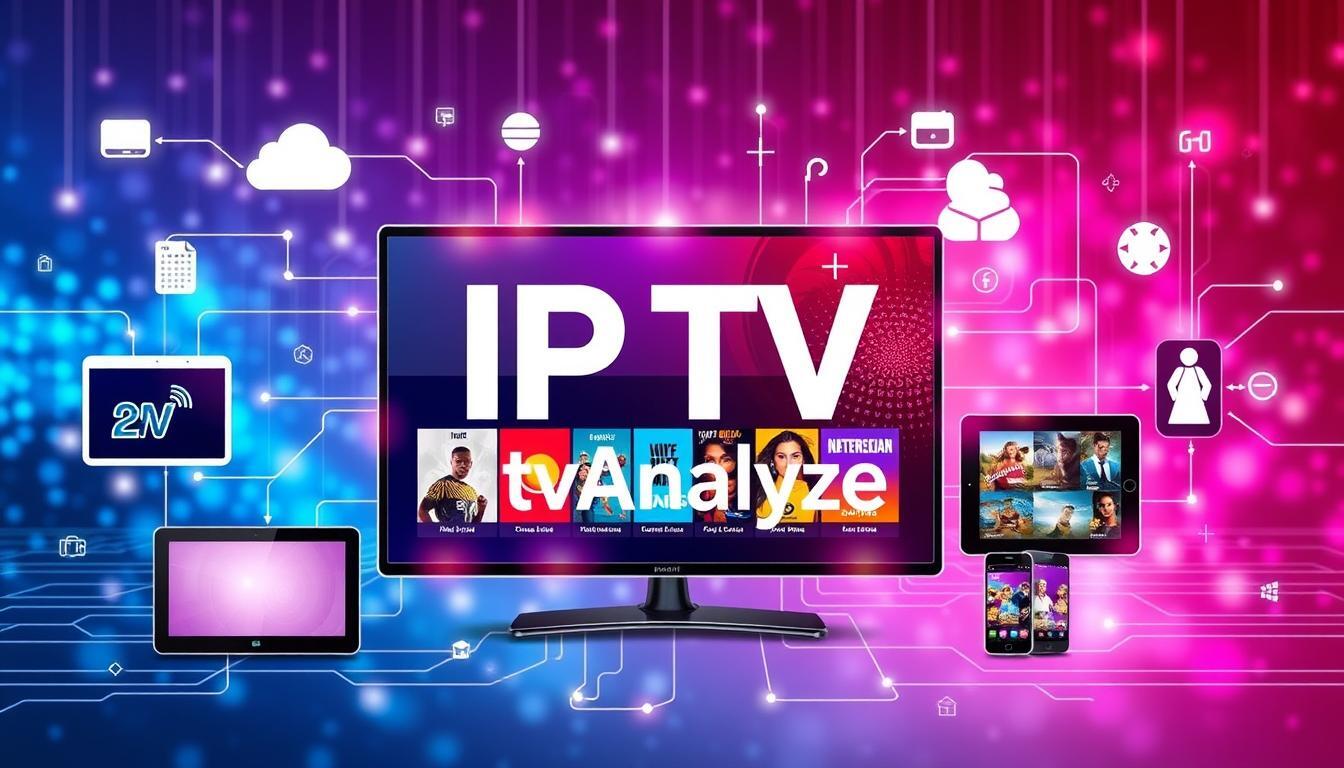What is IPTV, or Internet Protocol Television, is a new way to watch TV. It uses the internet to send TV shows and movies to your device. This makes watching TV more personal and interactive.
IPTV works by sending digital video and audio over the internet. This lets providers offer live TV, recorded shows, and on-demand content. You can access all this through an easy-to-use interface. IPTV services are given by special providers, ensuring quality and reliability.
Key Takeaways:
- IPTV is a technology that delivers television content over the internet or a private network, rather than traditional broadcast or cable TV methods.
- IPTV utilizes the TCP/IP protocol to transmit digital video and audio signals directly to viewers’ devices.
- IPTV services offer a range of features, including live TV, on-demand content, and personalized viewing experiences.
- IPTV providers offer various subscription models, with pricing ranging from $9.95/month to $44/month, and a variety of connection options.
- IPTV technology is gaining popularity globally, with the United States, United Kingdom, Canada, and Australia leading the adoption, and emerging markets like India, Brazil, and South Africa experiencing a surge in usage.
Introduction to IPTV
Definition and Background
IPTV, or Internet Protocol Television, is a new way to watch TV over the internet. It brings TV, video, audio, and more to your screen using the internet. This is different from old TV formats like satellite or cable.
The term “IPTV” started in 1995 with Precept Software’s IP/TV product. The 1990s saw big tech leaps in video and internet speeds. These changes made IPTV a reality.
IPTV lets you watch live TV or on-demand shows over the internet. It gives you a better, more personal TV experience. Unlike old TV, IPTV sends one show at a time, saving network resources and offering you what you want.
| Key Characteristics of IPTV | Description |
|---|---|
| Delivery Method | Uses Internet Protocol (IP) to deliver television content over an IP network, rather than traditional broadcast or satellite signals. |
| Content Types | Provides live TV, video-on-demand (VOD), and time-shifted media services. |
| Viewing Devices | Allows access to content on a variety of devices, including set-top boxes, smart TVs, and mobile devices. |
| Interactivity | Offers interactive features, such as personalized recommendations, pause/rewind live TV, and in-program messaging. |
IPTV is growing fast because of fast internet and the desire for on-demand content. It’s a more efficient and cost-effective way to watch TV. As it keeps improving, IPTV will be a big part of our media world, offering a great viewing experience everywhere.
How Does IPTV Work?
IPTV, or Internet Protocol Television, uses the internet to send video content to viewers. It uses broadband to deliver TV in a new way. This makes it different from old cable or satellite TV.
Understanding IPTV Technology
IPTV relies on IP multicasting to send data to many places at once. It uses Internet Group Management Protocol (IGMP) for live TV and Real-Time Streaming Protocol (RTSP) for on-demand shows. Multicast Listener Discovery helps with IPv6 networks.
IPTV content goes over a special network, like Digital Subscriber Line (DSL). This network controls the video quality and ensures it works well. IPTV sends only the chosen program directly to your device, unlike old TV ways.
| IPTV Delivery Methods | IPTV Protocols |
|---|---|
| IP Multicasting | Internet Group Management Protocol (IGMP) |
| Dedicated Network Infrastructure | Real-Time Streaming Protocol (RTSP) |
| Unicast Transmission | Multicast Listener Discovery (MLD) |
| Digital Subscriber Line (DSL) Connectivity | Real-Time Messaging Protocol (RTMP) |
| Hypertext Transfer Protocol (HTTP) |
These advanced technologies make IPTV a smooth and personal viewing experience. It meets the changing needs of today’s viewers.
IPTV vs. Traditional TV Delivery Methods
IPTV (Internet Protocol Television) and traditional TV differ in how they send content. Traditional TV broadcasts all shows at once. Viewers pick what they want by changing channels. IPTV, however, sends only the chosen show directly to your device.
IPTV offers more flexibility and personalization than traditional TV. It ensures better image and sound quality and is more secure. Traditional TV often faces issues like signal problems, limited channels, and compatibility issues.
| Feature | IPTV | Traditional TV |
|---|---|---|
| Content Delivery | Unicast | Multicast |
| Program Selection | On-demand | Channel-based |
| Image and Sound Quality | Superior | Varied |
| Network Security | Enhanced | Limited |
| Personalization | High | Low |
Services like Netflix, Hulu, and Amazon Prime Video are becoming more popular. They offer on-demand, high-quality TV experiences. These are not always available through traditional TV.
Advantages of IPTV
IPTV offers more flexibility than traditional TV. It uses video-on-demand (VOD) or time-shifted media. This lets viewers watch what they want, when they want, without a fixed TV schedule.
This iptv flexibility lets users watch content on their own schedule. It’s a big change from traditional TV.
IPTV also lets you watch content on different devices. You can use tablets, smartphones, and laptops to watch TV. This iptv device compatibility makes watching TV more convenient.
It’s easy to access your favorite shows anytime, anywhere. This is a big plus for many users.
Another great thing about IPTV is its interactivity and personalization. IPTV platforms can suggest content based on what you like. This makes watching TV more enjoyable and personalized.
“IPTV provides users with unprecedented control over their entertainment, empowering them to watch what they want, when they want, and on the device of their choice.”
In short, IPTV’s iptv advantages include flexibility, cross-device viewing, and personalized content. These features make IPTV a great choice for those who want a more customized TV experience.
Disadvantages of IPTV
Internet Protocol Television (IPTV) has many benefits, but it also has some downsides. One big challenge is needing a fast and stable internet connection. It also requires a lot of bandwidth to stream video content.
Another problem is that IPTV might have higher latency than traditional TV. This can be a big issue for live events or when you need to interact in real-time. Also, IPTV might not have as much content as cable or satellite TV. This is because IPTV providers have to get permission from content owners.
| IPTV Disadvantage | Description |
|---|---|
| iptv network requirements | IPTV needs a fast and stable internet connection and lots of bandwidth. This can be a problem for some users. |
| iptv latency | IPTV might have higher latency than traditional TV. This can be a big issue for live events or real-time interactions. |
| iptv content limitations | The content available on IPTV services might be limited compared to traditional TV. This is because IPTV providers have to get permission from content owners. |
The demand for IPTV services is growing fast, with a 30% to 35% annual increase globally. This shows how popular it’s becoming. But, it’s key for users to know the potential downsides of IPTV. This way, they can make a smart choice when picking their TV service.
IPTV Use Cases and Applications
IPTV, or Internet Protocol Television, is a versatile platform. It meets a wide range of entertainment and informational needs. It offers live TV, on-demand video streaming, and time-shifted media. These features have changed how we watch content.
Live TV, VOD, and Time-Shifted Media
Live television is a key use of IPTV. It lets viewers watch news, sports, and events in real-time, just like traditional TV. IPTV also provides video-on-demand (VOD) services. This gives users access to movies, TV shows, and more, anytime they want.
Moreover, IPTV offers time-shifted media. This lets viewers catch up on shows that have aired. It gives users more control over their viewing, fitting their schedules and preferences.
| IPTV Service | Description | Pricing |
|---|---|---|
| IPTVWORLDCONNECT | Offers a 36 free trial and a range of live TV, VOD, and time-shifted media options. | $9.95 – $44 per month |
| USAFIRESTICK | Provides a 24-hour free trial and a comprehensive selection of live channels, VOD, and time-shifted content. | $9.95 – $44 per month |
| Dark Media IPTV | Includes 4 connections and a diverse library of live TV, VOD, and time-shifted media. | $15 per month |
These examples show the iptv use cases and iptv applications. They highlight IPTV’s ability to deliver iptv live tv, iptv vod, and iptv time-shifted media to viewers.
Major IPTV Providers and Services
The IPTV world is full of different service providers. Each one meets the needs of various viewers. From big names to smaller ones, the IPTV scene is always changing. Some top IPTV providers and services are:
- Verizon (FiOS), AT&T (U-verse TV), and Comcast (Xfinity TV) – Big telecom companies with full IPTV services.
- DIRECTV (DIRECTV STREAM) and Dish Network (Sling TV) – Satellite TV giants now offering IPTV too.
- YouTube TV, Hulu + Live TV, and fuboTV – Top streaming sites with IPTV, live TV, and more.
There are also many smaller IPTV providers like Amazing TV, FalconTV, and SelectTV. They focus on specific content or areas, offering a wide range of iptv services and iptv content providers.
| IPTV Provider | Channels | Price (per month) | Trial Period | Specialization |
|---|---|---|---|---|
| BunnyStream | 16,000+ | $15 | 7 days | International content |
| Nomad IPTV | 15,000+ | $15 | None | Sports and PPV |
| Trendyscreen | 20,000+ | $15 | Occasional | Global channels |
| TiVistation | 23,000+ | $15 | 7 days | 4K streaming |
| IPTVtune | 10,000+ | $15 | Free trial | Budget-friendly |
| IPTV THE FOX | 18,000+ | $19 | None | Multi-device use |
| IP2TV | 18,000+ | $14.99 | 36 hours | USA families, Smart TVs, PCs, MAG Boxes |
These major iptv companies offer a wide range of iptv providers and iptv services. They meet different viewer needs and preferences. The IPTV world keeps growing, bringing new ways to enjoy media.
Is IPTV Free or Paid?
IPTV pricing models differ a lot. Some IPTV services are free, while others need a paid subscription. The choice between free and paid IPTV depends on what you need and what the provider offers.
Legal IPTV services, like those from big cable and satellite TV providers, usually cost money. These paid plans offer more channels, better video quality (up to 1080p HD), and extra features. You get catch-up TV, DVR, and access to live sports and PPV programs.
Free or freemium IPTV options are also out there. These are often from streaming platforms or niche IPTV providers. They might have fewer channels and ads to make money. But, they’re a cheap way to watch live and on-demand content without a monthly fee.
| IPTV Pricing Model | Key Features |
|---|---|
| Paid IPTV Services |
|
| Free IPTV Services |
|
When picking an IPTV service, think about what content you want, video quality, device support, and your budget. Paid IPTV services have more features, but free options can be cheaper for accessing content.
“The pricing and subscription models for IPTV can vary widely, with some providers offering tiered packages or a la carte content selection.”
what is iptv,Is IPTV free or paid?, how does iptv work?,Is IPTV a good option?
IPTV, or Internet Protocol Television, delivers TV content over the internet. It’s different from traditional cable or satellite TV. IPTV services can be free or paid, depending on the provider and what they offer.
Many IPTV services need a paid subscription, like cable or satellite TV. The cost can be between $10 and $50 a month. This depends on the number of channels and features. Some providers also have free or freemium options with less content or features.
Exploring IPTV Pricing Models
There are a few IPTV pricing models:
- Subscription-based: Users pay a monthly or annual fee. This includes live TV channels, on-demand content, and more.
- Pay-per-view: IPTV providers let you buy individual events, movies, or TV shows. You don’t need a subscription.
- Freemium: Some services have a free tier with limited content. You pay for premium features or more channels.
It’s key to know that IPTV legality can vary. Some services may offer unauthorized content. Make sure to use a legitimate IPTV service to avoid legal problems.
IPTV can be a good choice for those wanting to leave traditional TV behind. It’s often cheaper and more flexible. But, it’s important to understand the pricing and legality before signing up.
IPTV Device Requirements
To access IPTV services, you need devices that can connect to the internet. These devices must support the streaming protocols needed. You might use a set-top box, smart TV, or a device that mirrors a computer screen on a TV.
Older TVs might not work with IPTV. They might need a set-top box to handle the IPTV signal.
New smart TVs can connect directly to the internet. They support IPTV services. Some IPTV providers offer their own set-top boxes or suggest specific devices for the best viewing.
IPTV Compatible Devices
Here are some popular devices for IPTV:
- Android-based streaming devices like Amazon FireStick, Amazon Fire TV Cube, NVIDIA Shield, and Chromecast with Google TV
- Smart TVs with IP support from brands like Samsung, LG, Sony, and Vizio
- IPTV set-top boxes from certain IPTV providers
- Devices that can mirror a computer screen to a TV, such as Roku, Apple TV, and Google Chromecast
| Device | Minimum Internet Speed Required | Availability on Official App Stores | Maximum Video Resolution |
|---|---|---|---|
| Android-based Streaming Devices | 25Mbps | Yes (Amazon App Store, Google Play Store) | 1080p HD |
| Smart TVs | 25Mbps | Yes (Manufacturer App Stores) | 1080p HD |
| IPTV Set-top Boxes | 25Mbps | Varies by Provider | 1080p HD |
| Screen Mirroring Devices | 25Mbps | Yes (Official App Stores) | 1080p HD |
Keep in mind, the video quality depends on your device and internet speed. A 25Mbps internet connection is usually needed for the best streaming.
The Future of IPTV
The future of IPTV is looking good, with the global market expected to double by 2029. As more people start using IPTV, new trends and predictions are shaping its future.
Hybrid IPTV Models
The IPTV market will see more hybrid models. These mix traditional TV with IP-based delivery. This means viewers can enjoy live channels, on-demand content, and interactive features all in one place.
Expansion of Live IPTV Offerings
Live TV is key to the IPTV experience. Expect more live IPTV in the future. New tech will make live streams better and faster, improving how we watch TV.
Integration with IP-Based Services
The future of IPTV includes working better with other IP services. This means smart homes, voice assistants, and IoT devices will all work together with IPTV. It’s all about making things easier for viewers.
Growth of Niche and User-Generated Content
As IPTV adoption grows, so will niche and user-generated content. This lets creators reach specific audiences. It also gives viewers more choices in what they watch.
The future of IPTV looks bright, thanks to new tech and changing viewer habits. IPTV is set to become a big part of our TV and video watching lives.
Getting Started with IPTV
Start your journey into IPTV (Internet Protocol Television) by learning how to set it up. It’s simple, whether you’re tech-savvy or new to IPTV. The steps for how to get iptv, iptv setup, and iptv installation are straightforward. The iptv subscription process differs by provider but is generally easy.
First, look into the IPTV providers available in your area. Think about the content, price, device support, and the provider’s reputation. After picking a service, make sure you have the right equipment, like a compatible set-top box or smart TV.
Getting an IPTV subscription involves a few steps. You’ll sign up, give personal and payment details, and possibly set up hardware and software. Many providers offer help to make sure you get everything working right.
| Key Considerations | Recommended Specifications |
|---|---|
| Internet Speed for UHD Streaming | Minimum 25 Mbps |
| Internet Speed for Standard Streaming | Minimum 10 Mbps |
| Common IPTV Streaming Devices | Smart TVs, Streaming Boxes (Roku, Amazon Firestick, Nvidia Shield), Computers, Smartphones |
| IPTV Subscription Options | Affordable Paid Plans with Free Trials |
To start with IPTV, compare providers, get the right equipment, and follow the subscription steps. With proper setup and a good internet connection, you’ll enjoy IPTV without any hassle.
IPTV vs. OTT and Internet TV
IPTV, over-the-top (OTT) services, and internet TV all stream video over the internet. But they differ in key ways. Knowing these differences helps you pick the best option for watching your favorite shows.
IPTV comes from telecoms and uses a managed network. This means better quality and reliability, especially for live sports. In contrast, OTT services like Netflix stream directly over the internet. They don’t have the same network control as IPTV.
Internet TV is TV content on websites via broadband. It lacks the network management of IPTV. IPTV uses a closed network, while OTT and internet TV use the public internet. This can lead to speed and connectivity issues.
| Feature | IPTV | OTT | Internet TV |
|---|---|---|---|
| Network | Managed or closed network | Public internet | Public internet |
| Service Provider | Telecom or service provider | Independent OTT platforms | Website-based |
| Video Quality | High-quality, reliable | Depends on internet speed | Depends on internet speed |
| Live TV | Optimized for live events | Limited live TV options | Limited live TV options |
| Pricing | May have monthly fees | Typically more affordable | Varies depending on service |
In summary, IPTV, OTT, and internet TV all stream video online. But they differ in technology, network, and service. Knowing these differences helps you choose the best streaming option for you.
Conclusion
IPTV, or Internet Protocol television, is changing how we watch TV. It offers a more flexible and interactive way to enjoy shows compared to old TV methods. IPTV uses the internet to stream live TV, on-demand videos, and even shows you can watch later.
While IPTV brings many benefits, like watching on different devices, it also has its challenges. These include needing strong internet, limited content, and legal issues. Yet, as technology advances and what people want changes, IPTV’s future looks bright. Experts predict it will grow a lot and blend with other internet services.
Knowing the basics of IPTV can help you choose better for your entertainment needs. The key takeaways of IPTV show its fast growth, new services, and big impact on TV’s future. This summary is key for anyone interested in the latest in video entertainment.
FAQ
What is IPTV?
IPTV stands for Internet Protocol television. It delivers TV shows and videos over the internet. This is different from traditional TV, cable, or satellite.
How does IPTV work?
IPTV uses special protocols to stream TV and videos. It works over a network that ensures quality and reliability. This means better viewing experience.
What are the advantages of IPTV?
IPTV offers more flexibility and on-demand viewing. It works on various devices and personalizes your TV experience.
What are the disadvantages of IPTV?
IPTV needs a fast and stable internet connection. It might have higher latency than traditional TV. Also, content availability can vary.
Is IPTV free or paid?
IPTV can be free or require a subscription. It depends on the provider and what they offer. Some services are free, while others need a paid subscription.
What devices are required for IPTV?
You need a compatible device to use IPTV. This could be a smart TV, set-top box, or a device that mirrors a computer screen. Older TVs might need an extra box.
What is the future of IPTV?
The IPTV market is growing fast. Expect more hybrid models, live content, and integration with other services.
How does IPTV differ from OTT and internet TV?
IPTV is different from OTT and internet TV. IPTV is provided by telecoms over a managed network. OTT and internet TV use the public internet directly.
Have any questions or need more information? Feel free to ask! We’re here to help. Simply drop your question below, and we’ll get back to you as soon as possible!










